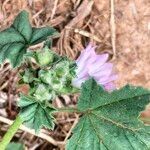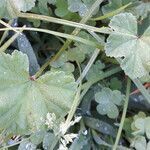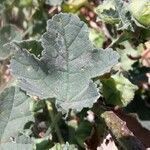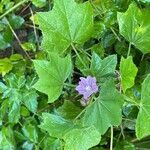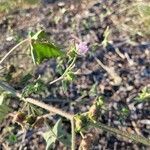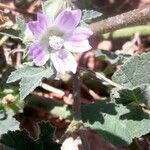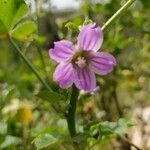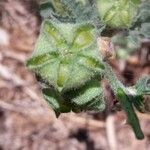Herbs, annual or biennial, 0.2–0.6 m, sparsely to densely hairy, hairs both simple and stellate. Stems procumbent or trailing to ascending, villous-hirsute. Leaves: stipules persistent, ovate to broadly ovate, 4–6 × 3–5 mm; petiole 2–5 times as long as blade; blade semicircular or reniform, 2–4 × 2–4 cm, sometimes to 12 cm in young plants, base cordate to nearly truncate, distalmost leaves sometimes wide-cuneate, margins crenate or dentate, undulate, or with 5–7 shallow, lobes, apex obtuse, rounded, or acute, surfaces sparsely hairy, hairs simple. Inflorescences stellate; petals pink to lavender, drying bluish, usually with darker veins, 5–15 mm, subequal to or length slightly less than 2 times calyx, glabrous or nearly so; staminal column 2–2.5(–3) mm, densely, retrorsely puberulent, hairs simple; style 7–10-branched; stigmas 7–10. Schizocarps 6–7 mm diam.; mericarps 7–10, 3 mm, thick, as wide as long, margins sharp-angled but not winged, conspicuously, deeply reticulate-pitted apically, surfaces densely hirsute or glabrous. Seeds dark brown, 2–2.5 mm. 2n = 42.
More
Annual or short-lived perennial, procumbent, ascending or erect herb. Stems sparsely to moderately hairy with usually simple hairs. Lvs glabrous to sparsely hairy with usually simple hairs and rarely stellate hairs above, sparsely to moderately hairy below, reniform to orbicular, obtuse to cordate at base, shallowly or moderately 5-7-palmately lobed and crenate, 1-10-(15) cm diam.; petioles 1-20-(30) cm long; stipules broadly ovate with acute apex, 2-8 mm long. Fls in axillary clusters of (1)-2-6; fruiting pedicels 2-10-(15) mm long; epicalyx segments narrowly ovate-oblong to broadly ovate, ± = calyx at flowering; calyx teeth broadly ovate-triangular, sparsely hairy with simple or stellate hairs and ciliate on teeth but lower tube ± glabrous, slightly enlarged at fruiting; petals pale lilac or pink with darker veins and tips, about 2× length of calyx, 6-10 mm long. Mericarps 8-9-(10) per fr., often hairy when immature but usually becoming glabrous, strongly reticulately veined on back; edges sharply angled but not winged.
An annual or biennial herb. It grows 40 cm tall. It has soft wooly hairs. The flower petals are dark lilac and without darker veins. They are 7-12 mm long. The fruit stalks are longer than least mallow (Malva parviflora). They are 10 mm long or longer.
The leaves are boiled and seasoned with lemon and oil then eaten. The young fruits are eaten raw as a snack. The leaves are cooked, mixed with flour then cooked again and eaten. The leaves are used for sarma in Turkey. They are rolled around a filling of rice or minced meat.
